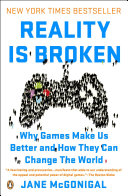

In 'Reality Is Broken', Jane McGonigal argues that games provide a unique form of happiness that is often lacking in real life. She explains that games create a sense of achievement, social connection, and purpose. In contrast, many aspects of reality can feel mundane or frustrating. Games allow players to experience a flow state, where they are fully immersed and engaged in an activity. This state is often linked to increased happiness and satisfaction. McGonigal emphasizes that the mechanics of games—such as clear goals, immediate feedback, and the ability to level up—can be harnessed to improve real-life experiences. By incorporating game-like elements into everyday tasks, individuals can find more joy and fulfillment in their lives, ultimately leading to a happier society.
Continue readingMcGonigal delves into the principles of game design and how they can be applied beyond gaming. She discusses the importance of creating engaging experiences that captivate players and motivate them to take action. Effective game design incorporates elements such as challenges, rewards, and narrative, which can be translated into real-world scenarios. For instance, by designing tasks with clear objectives and rewards, people are more likely to engage in them. The book highlights how businesses, educational institutions, and even governments can benefit from applying game design principles to enhance productivity, learning, and civic engagement.
Continue readingOne of the core themes of 'Reality Is Broken' is the idea that games foster collaboration and collective effort. McGonigal points out that many games require players to work together to achieve common goals, which can lead to stronger social bonds and a sense of community. She argues that this collaborative spirit can be harnessed to tackle real-world issues, such as climate change or poverty. By creating games that encourage players to collaborate on solving these problems, we can mobilize collective action and drive positive change. The book provides examples of successful initiatives that have used game mechanics to engage communities in meaningful ways.
Continue readingMcGonigal emphasizes that games can be powerful tools for problem-solving. She discusses how game-based simulations can be used to model complex systems and explore potential solutions to real-world challenges. For instance, games can simulate economic scenarios, environmental impacts, or social dynamics, allowing players to experiment with different strategies and see the consequences of their actions. This experiential learning can lead to deeper understanding and innovative solutions. The book presents various case studies where game-based approaches have successfully addressed critical issues, showcasing the potential of games as a medium for exploration and discovery.
Continue readingFailure is an integral part of gaming, and McGonigal argues that this aspect can be beneficial for personal growth and resilience. In games, players often face setbacks but are encouraged to learn from their mistakes and try again. This iterative process fosters a growth mindset and helps individuals develop coping strategies for real-life challenges. The book highlights the importance of reframing failure as a learning opportunity rather than a defeat. By embracing failure in both games and life, individuals can cultivate resilience and adaptability, which are crucial skills in an ever-changing world.
Continue readingMcGonigal explores the positive impact of games on mental health. She discusses how gaming can serve as a form of escapism, providing relief from stress, anxiety, and depression. Additionally, games can promote social interaction, which is essential for emotional well-being. The book presents research indicating that playing games can lead to improved mood and reduced feelings of isolation. McGonigal advocates for the therapeutic potential of games, suggesting that they can be integrated into mental health treatment to help individuals cope with their challenges more effectively.
Continue readingIn the concluding sections of the book, McGonigal envisions a 'gameful' world where game design principles are woven into the fabric of everyday life. She encourages readers to think creatively about how to incorporate game mechanics into various aspects of society, from education to public policy. The goal is to create environments that inspire engagement, collaboration, and problem-solving. By fostering a culture that values play and creativity, McGonigal believes we can address some of the most pressing challenges facing humanity. The book concludes with a call to action, urging individuals and organizations to embrace the potential of games to create positive change.
Continue reading